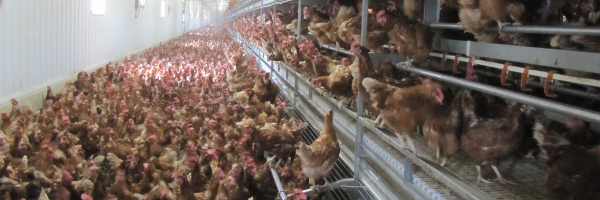22
May
Take Action: Tell USDA to Crack Down on “Organic” Livestock Factories
(Beyond Pesticides, May 22, 2020) For years, USDA has been looking the other way as giant corporate agribusinesses, primarily producing conventional eggs and poultry, have squeezed family-scale farmers out of the market and misled and defrauded consumers.
Due to a lawsuit challenging the Trump administration on the scuttling of new rules that would make it harder for factory farms to qualify for organic status, USDA is seeking input on what was previously an error-filled and biased economic assessment of the rulemaking.
If you would prefer to write your own custom comment you can submit it on Regulations.gov.
Letter to National Organic Program (Jenny Tucker, Ph.D.
To the National Organic Program:
Please include my comment below in evaluating the economic analysis report pursuant to the Organic Livestock and Poultry Practices rulemaking.
Docket number: AMS-NOP-20-0037
Both the current and previous OLPP analyses include the following misstatements and omissions:
- It is a misconception to refer to, and judge, the economic impacts of the OLPP as if the requirement for outdoor access was a new and onerous regulation. In fact, from the beginning of the USDA organic program, “all” organic livestock have been required to have access to the outdoors. The new proposed rule does nothing more than create some enforceable benchmarks to facilitate oversight by USDA and its accredited third-party certifiers.
- Analyzing the economic impact, as if this were a new regulatory obligation, is misdirected. All organic livestock producers should have been providing meaningful outdoor access from day one.
- Factoring in impacts on retail pricing is not germane to this decision-making. The size of the market is irrelevant. When consumers pay a premium for organic eggs and poultry, they expect that the birds are being managed in accordance with the law, which requires outdoor access and promotion of the natural instinctive behaviors of the animals.
- True organic management of meat birds and laying hens is not currently possible in the massive industrial-sized buildings that USDA has allowed to be certified. Investments were made in these structures while it was known that elements in the organic industry were challenging the legality of the operations and, thus, their investments have always been at risk.
- In England and the European Union, organic birds have always had access to the outdoors in smaller flocks. Subsequently, the price differential between conventional and organic eggs has been greater. However, the market share for organic in many of those countries surpasses that of the United States. Organic consumers already assume that they are buying eggs and poultry produced with a higher level of animal welfare. They are currently being defrauded. The question of their willingness to pay a premium is irrelevant.
- If some of the larger operators are forced to exit, entrepreneurs will quickly scale-up to meet new market demand. The shift to producers who comply with both the spirit and letter of the law should not be a factor in implementing the new rulemaking.
- Regardless of how much outdoor space is provided, it is not possible to offer legitimate access when birds are housed in giant, multitiered aviary systems. Buildings housing as many as 100,000-200,000 birds prevent the expression of instinctual behavior, a regulatory requirement, as it would be necessary to walk over thousands of other birds in order to access a door. Believing otherwise is a myth perpetuated by corporate interests in egg production.
- Because USDA’s analysis starts from the wrong baseline—one that is not consistent with the law–the analysis omits the economic injury to family-scale farmers who are currently complying with the regulations by allowing birds meaningful access to the outdoors that continues when the OLPP is not implemented. Furthermore, there are many family farmers who have been prevented from entering the organic market for poultry meat and eggs because, as it has grown, market share has been dominated by giant conventional ag companies that have gamed the system to achieve lower operating costs and higher profitability.
In conclusion, any economic analysis of the impact of new rulemaking should be viewed through the prism of the Organic Foods Production Act and its current regulations. To do otherwise places family farmers at a competitive disadvantage and perpetuates a fraudulent myth that the majority of organic poultry, managed by corporate agribusiness, is truly “organic.”











